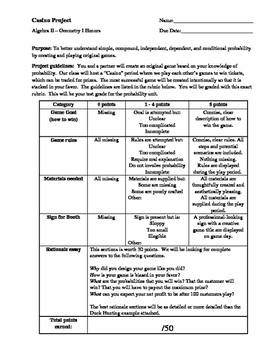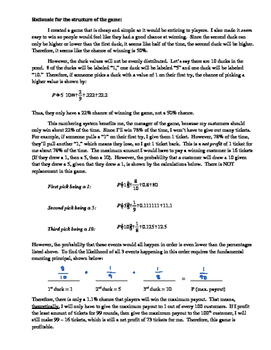Carnival Probability Project
Weapon of Math Instruction
10 Followers
Grade Levels
8th - 12th
Subjects
Resource Type
Standards
CCSS8.SP.A.1
CCSS8.SP.A.2
CCSS8.SP.A.3
CCSS8.SP.A.4
Formats Included
- Word Document File
Pages
4 pages
Weapon of Math Instruction
10 Followers
Description
A project that feels like a game!
Students must create their own game, using probability to ensure THEY are favored to win....much like the house in a casino. Students can make games involving dice, spinners, cards, "fishing" ducks out of a pond, etc.
Assessed skills include: fundamental counting principal, theoretical probability, experimental probability, independent events, dependent events, creativity, writing, presentation. *Students must already know basic probability to complete this project.
Including 20 minutes for introduction, 120 minutes for brainstorming and creation, 60 minutes of "game day," and 20 minutes for reflection and debrief, this activity could take as much as a week. It all depends on how much time you give students to create their games during class time.
This project can be used as an activity to deepen learning, a super engaging way to have students show off what they're doing in math class, or an alternative assessment. The document includes a detailed grading rubric for teacher use. It also includes student feedback sheets for students to give to each other after they play test their games.
Students must create their own game, using probability to ensure THEY are favored to win....much like the house in a casino. Students can make games involving dice, spinners, cards, "fishing" ducks out of a pond, etc.
Assessed skills include: fundamental counting principal, theoretical probability, experimental probability, independent events, dependent events, creativity, writing, presentation. *Students must already know basic probability to complete this project.
Including 20 minutes for introduction, 120 minutes for brainstorming and creation, 60 minutes of "game day," and 20 minutes for reflection and debrief, this activity could take as much as a week. It all depends on how much time you give students to create their games during class time.
This project can be used as an activity to deepen learning, a super engaging way to have students show off what they're doing in math class, or an alternative assessment. The document includes a detailed grading rubric for teacher use. It also includes student feedback sheets for students to give to each other after they play test their games.
Total Pages
4 pages
Answer Key
Included with rubric
Teaching Duration
3 days
Report this resource to TPT
Reported resources will be reviewed by our team. Report this resource to let us know if this resource violates TPT’s content guidelines.
Standards
to see state-specific standards (only available in the US).
CCSS8.SP.A.1
Construct and interpret scatter plots for bivariate measurement data to investigate patterns of association between two quantities. Describe patterns such as clustering, outliers, positive or negative association, linear association, and nonlinear association.
CCSS8.SP.A.2
Know that straight lines are widely used to model relationships between two quantitative variables. For scatter plots that suggest a linear association, informally fit a straight line, and informally assess the model fit by judging the closeness of the data points to the line.
CCSS8.SP.A.3
Use the equation of a linear model to solve problems in the context of bivariate measurement data, interpreting the slope and intercept. For example, in a linear model for a biology experiment, interpret a slope of 1.5 cm/hr as meaning that an additional hour of sunlight each day is associated with an additional 1.5 cm in mature plant height.
CCSS8.SP.A.4
Understand that patterns of association can also be seen in bivariate categorical data by displaying frequencies and relative frequencies in a two-way table. Construct and interpret a two-way table summarizing data on two categorical variables collected from the same subjects. Use relative frequencies calculated for rows or columns to describe possible association between the two variables. For example, collect data from students in your class on whether or not they have a curfew on school nights and whether or not they have assigned chores at home. Is there evidence that those who have a curfew also tend to have chores?





